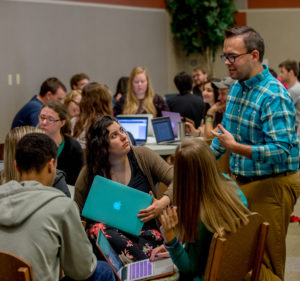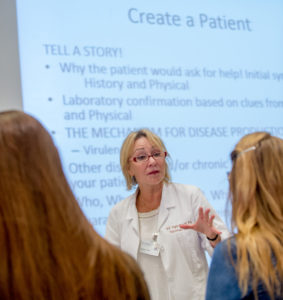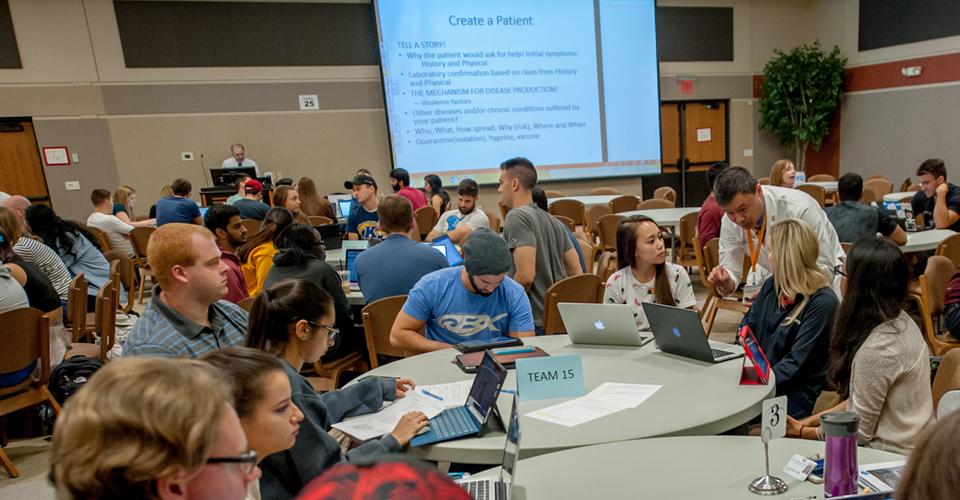It takes a team to outsmart a bug.
With the help of high-energy clinical faculty members, a roomful of second-year medicine and pharmacy students teamed up recently in a Bug-Based Learning session led by Angelo DeLucia, Ph.D., co-course director of the Infection and Immunity course. The students have been learning about bacterial infections in their infectious disease course. Now, gathered in small interprofessional groups and with the assistance of visiting clinical faculty members with expertise in infectious disease, they were ready to tackle a challenge.
To help students begin preparing for the leap from the theoretical to the real world of interacting with patients, each group was asked to create a patient avatar who embodied the infection they had been assigned. Tell a story, they were urged: What symptoms might have led the patient to have come to them for help? What other diseases or chronic conditions did the patient have? How would they make the diagnosis? (What lab tests would they run?) How, and to whom, might the disease spread?
“First, they need to know the basic science of how the bacteria causes the disease; that’s what we mean by virulence,’’ said Dr. DeLucia. Listening in lectures, or looking at bacteria in labs, students learn theoretical facts. Now, said Dr. DeLucia, they were ready for the next step: applying their knowledge and research skills to an imaginary clinical situation.
Michael Tan, M.D., associate professor of internal medicine and co-course director for the College of Medicine with Dr. DeLucia, joined clinical faculty members Kevin Frey, M.D., clinical assistant professor; Bhavin Mistry, Pharm. D., assistant professor of pharmacy practice and co-course director for the College of Pharmacy infection and immunity course; and Denise Signs, M.D., assistant professor of internal medicine, to circulate around the room that day, interacting with students. “The nice thing about bringing clinicians into this setting is for students to get exposure to the thought process involved in working with patients,’’ said Dr. Tan, shown at right in the photo at the top.
Richa Raina, a medicine student, said her team was working to determine whether the patient had a more common version of Mycobacterium Avium Complex (MAC) related to tuberculosis, or a rarer strain. Filling out the patient avatar’s backstory, the group noted that their patient had been spending a lot of time in his rose garden and might have encountered bacteria in the soil, where it’s commonly found.
Alissa White, a pharmacy student on the team, said she appreciated the chance to ask the clinical faculty members questions as they circulated around the room, making it possible for students to get more information on a particular area without feeling they were holding up the rest of the class. Team member Devrajsinh Solanki, also a pharmacy student, added, ‘’They are experts on the subject and we need that. It’s also wonderful to have personalized teaching.’’
Career Advice, Too
 Stopping by one table, Dr. Frey (pictured to the right) asked the group to picture a patient working on an outdoor pool, and explained the chronic wound infections that happen with surprising frequency in patients who have recently had plastic surgery. Paige Schertzinger, a medicine student, took the opportunity to ask Dr. Frey if he was an infectious disease doctor. “I’m an infectious disease nerd!’’ responded the enthusiastic physician, going on to answer Schertzinger’s career question about specializing in pediatric infectious disease.
Stopping by one table, Dr. Frey (pictured to the right) asked the group to picture a patient working on an outdoor pool, and explained the chronic wound infections that happen with surprising frequency in patients who have recently had plastic surgery. Paige Schertzinger, a medicine student, took the opportunity to ask Dr. Frey if he was an infectious disease doctor. “I’m an infectious disease nerd!’’ responded the enthusiastic physician, going on to answer Schertzinger’s career question about specializing in pediatric infectious disease.
“It’s easier than Googling ‘How do you become an infectious disease doctor,’’’ said Schertzinger afterward. Also appreciative was Mason Fowler, a pharmacy student at the same table who said he’s always interested in watching people’s body language. “Dr. Frey is extremely confident. I didn’t question a thing he said. When you see someone who knows exactly what they’re talking about, you think, OK, I’ll get there someday!’’
 One group remained after the 45-minute session ended to keep talking with Dr. Signs (pictured to the right). She complimented them on their thoroughness, then added a caveat: “In real life, you’re not going to do all these labs.’’ They were learning common causes of bacterial food infection, Dr. Signs explained afterward. She was helping them understand practical considerations. “In real life, when someone has vomiting and diarrhea, you’re not going to need to do all that testing. Experience will guide you, and you’ll make a more cost-effective choice.’’
One group remained after the 45-minute session ended to keep talking with Dr. Signs (pictured to the right). She complimented them on their thoroughness, then added a caveat: “In real life, you’re not going to do all these labs.’’ They were learning common causes of bacterial food infection, Dr. Signs explained afterward. She was helping them understand practical considerations. “In real life, when someone has vomiting and diarrhea, you’re not going to need to do all that testing. Experience will guide you, and you’ll make a more cost-effective choice.’’
Like the other faculty that day, Dr. Signs was energized from the event. “I love teaching this session,’’ she said. “My role is to give them a little glimmer of what clinical practice will be like.’’
